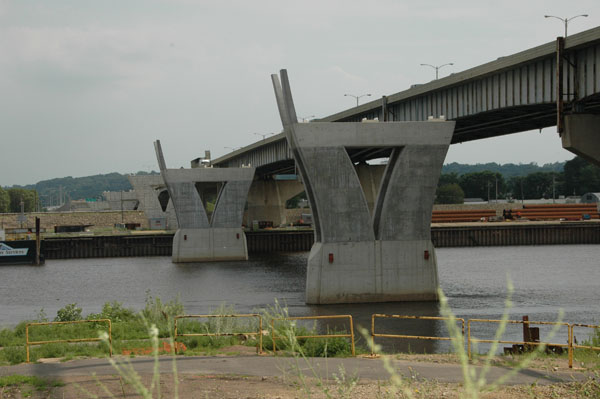
The Hwy 52 Lafayette Bridge over the Mississippi River in St. Paul is one of the 172 bridges identified in MnDOT’s Trunk Highway Bridge Improvement Program, which is intended to accelerate the repair or replacement of the state’s fracture critical or structurally deficient bridges over 10 years. To date, 65 of those bridges are substantially complete, with another 12 bridges expected to be complete by the end of the 2012 construction season. Photo by Nick Carpenter |
Five years after the Interstate 35W bridge in Minneapolis collapsed into the Mississippi River, a number of changes to bridge management programs here in Minnesota and nationally have been adopted to ensure the overall safety of the nation’s bridges.
“Many lives were changed on Aug. 1, 2007,” said Nancy Daubenberger, state bridge engineer. “We have worked very hard to make sure that this tragedy has resulted in positive bridge safety improvements, both in Minnesota and nationally.”
After months of investigation during 2007 and 2008, the National Transportation Safety Board determined that the probable cause of the collapse, which killed 13 people and injured 145 others, was inadequate load capacity due to a design error of some of the bridge’s gusset plates. According to the report, the failure occurred under a combination of factors—substantial increases in the weight of the bridge from previous modifications and the concentrated traffic and construction loads on the day of the collapse.
“If the bridge had been properly designed, these additional loads would have been within the appropriate safety factors,” Daubenberger said. “The 35W bridge collapse highlighted the need for increased national attention to bridge safety, and drove several improvements in state transportation department bridge programs, including MnDOT’s.”
Notable changes in MnDOT’s bridge program since 2007 include:
- Major bridges now require a formal independent peer review during design to minimize the risk of a critical design error. MnDOT hires separate engineering firms to conduct the reviews.
- Statewide staffing to perform bridge maintenance has increased by about 50 percent, or 55 positions.
- MnDOT has conducted research into advanced bridge monitoring techniques, such as acoustic emissions monitoring and infrared thermography. The department uses these techniques where appropriate, but still considers traditional visual and physical inspection as the foundation of condition assessment, according to Tom Styrbicki, bridge construction and maintenance engineer.
- MnDOT has changed its bridge construction specifications to place limits on equipment and material stockpiles on bridges.
- Specific performance measures have been instituted for bridge inspection and maintenance. These measures place performance targets on timeliness of inspections and maintenance accomplishments.
- MnDOT has developed a customized, state-of-the-art Structure Information Management System. Within the system, bridge inspection and maintenance actions are integrated to identify condition, plan and prioritize maintenance need, document and report on accomplishments, and assess benefit of maintenance activities.
In addition, the 2008 Legislature provided $2.5 billion over 10 years to replace or repair the state’s fracture critical and structurally deficient bridges, such as the Hwy 52 Lafayette Bridge in St. Paul, currently under construction, and the Hwy 23 DeSoto Bridge in St. Cloud, which already has been replaced. Of the 172 bridges identified and funded by the Chapter 152 program, an estimated 120 bridges will be under contract to be replaced or rehabilitated by June 30, 2018. The remaining bridges were either:
- Under construction at the time the program was established
- Classified as lower priority and not required to be funded as part of the program
- Privately owned or needing no work other than routine maintenance until after 2018
The status of the 172 bridges is as follows:
- 65 bridges substantially complete
- 12 other bridges to be complete by the end of the 2012 construction season
- 65 bridges scheduled to be under contract for repair or replace in 2013-2018
- 27 bridges judged to need only routine maintenance until beyond 2018
- 3 bridges are either privately owned or do not carry state trunk highway traffic
The most recent Chapter 152 update report can be found at www.dot.state.mn.us/planning/program/pdf/CH152AnnualInventoryReport2012.pdf.
The NTSB also recommended to the Federal Highway Administration and the American Association of State Highway and Transportation Officials changes in bridge management on a national level, including developing and implementing a bridge design quality assurance/quality control program for bridge owners; developing specifications and guidelines for bridge owners to ensure that construction loads and material stockpiles do not overload structural members or connections; and modifying and updating manuals and training, especially with regard to inspecting and responding to gusset plate issues. |



